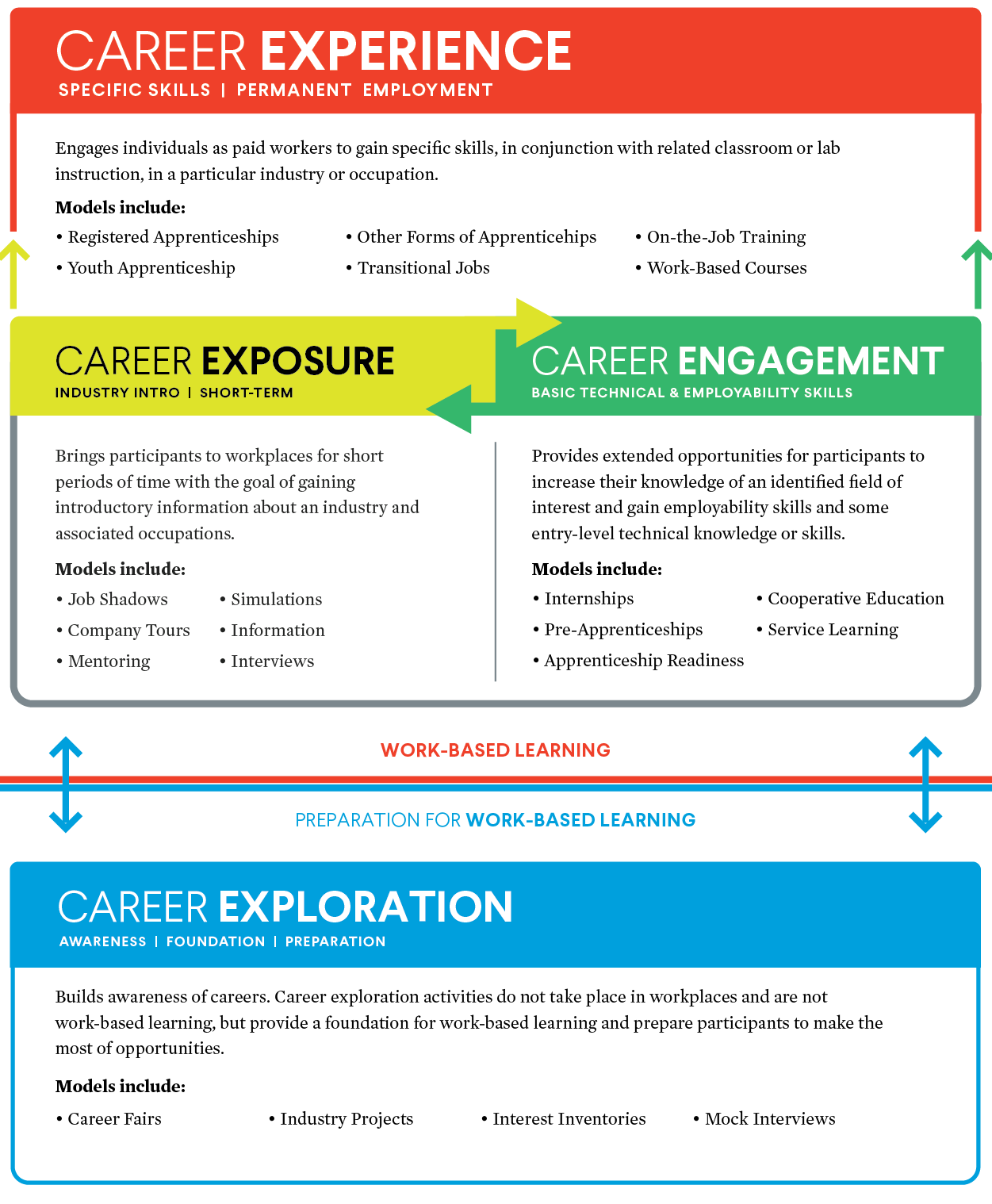October 19, 2021
What It Is
- Work-based learning is an approach to education and training in which a student completes meaningful job tasks in a workplace that develop readiness for work, knowledge, and skills that support entry or advancement in a career.
- Work-based learning encompasses multiple models, such as job shadows, internships, and apprenticeships, that vary in intensity, time commitment, and pay. Each has a different purpose and outcomes related to improved career navigation and success.
- Work-based learning helps make academic subjects relevant to participants’ career interests. Students have opportunities to apply the technical knowledge and skills learned in a classroom in an actual workplace. Students learn to solve problems in real time, solicit and learn from feedback, engage with business and industry professionals, and develop, apply, and practice foundational employability skills.
JFF’s Work-Based Learning Framework

Why It Matters
- Work-based learning is key to overcoming the common challenge of getting a job without work experience. Research shows that over 90 percent of employers prefer job candidates with prior experience—even for entry-level positions. Employers say that internships are the top differentiator when choosing between two otherwise equally qualified candidates.
- Students report that interactions with industry professionals are the most useful source of information about careers and related educational pathways.
- Work-based learning drives equity. It provides students from all backgrounds—not just those who are well connected—with opportunities to build professional networks and social capital, gain insight into workplace dynamics and how to navigate them, and earn income while developing skills aligned to a career of interest.
- Employers get to know prospective employees from a wider variety of backgrounds and expand their talent pipelines. Many report that they benefit from students’ creativity, knowledge of technology, and innovative ideas.
What It Looks Like
- All students in a pathway participate in a series of structured work-based learning experiences aligned with the industry focus of the pathway.
- Students gain career-related knowledge and competencies—including technical and employability skills—through work-based learning experiences aligned with classroom learning.
- Students have opportunities to discuss and glean lessons from their work experiences and reflect on the connections between work-based and classroom learning. Students also learn about career ladders, salaries and benefits, safe and healthy working conditions, employer perspectives, and how to handle complex issues such as sexual misconduct and hiring discrimination.
What Role Partners Play
- Secondary and postsecondary educators, employers, and intermediaries collaboratively design a continuum of work-based learning experiences and arrange for students to be paid for their work in models such as internships and apprenticeships.
- Secondary and postsecondary educators prepare students to participate in work-based learning and connect their experiences to classroom learning.
- Employers provide opportunities for young people to enter workplaces and work with industry professionals.
- Intermediaries manage all logistics, including brokering work-based learning opportunities across the region, developing job descriptions, managing student placements, supporting employers in addressing legal and liability concerns, executing agreements between employers and schools, and developing curricula and assessments in partnership with educators and employers.
Related Content

The Business Case for Work-Based Learning
JFF can help JFF works with top companies like Lockheed Martin, John Deere, Nissan, Honda, and Best Buy to put work-based learning into action. We help companies assess their business drivers, evaluate talent needs, and…

Work-Based Learning Glossary
A apprenticeship A workforce training model that combines paid on-the-job learning and formal classroom or online instruction to help a worker master the knowledge, skills, and competencies needed for career success. These programs generally vary…

Benefits of Work-Based Learning
Work-based learning solves a problem that many jobseekers face: It’s hard to get a job without previous work experience, and it’s hard to get work experience without a job. Why Work-Based Learning? Work-based learning solves…

System Navigator: Work-Based Learning
This System Navigator will help you identify the key connection points of your work-based learning system. This System Navigator will help you identify the key connection points of your work-based learning system. Whether you are…

Making Work-Based Learning Work
Work-based learning helps alleviate a common issue for jobseekers: meeting a “relevant work experience” prerequisite that is hard to gain outside of the workplace. Americans seeking employment often face a conundrum: relevant work experience is…
